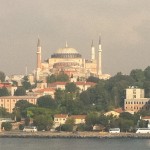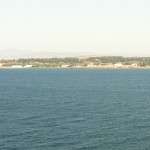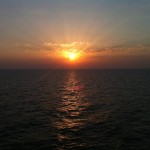
This morning we reentered the Bosphorus at its northern-most point, where it meets the Black Sea. The rest of the day we cruised down the Bosphorus Strait, past Rumeli Castle, the Golden Horn and Istanbul, through the Sea of Marmara and into the Dardanelles. As the sun was setting, we entered the Aegean Sea.
The castles we passed at the entrance to the Bosphorus, as we neared Istanbul, and as we exited the Dardanelles whispered tales of past battles and sieges.
There is the tale of the Fourth Crusade, on its surface one of the most bizarre twists in history, where the Crusaders left home intending to conquer Muslim-controlled Jerusalem and in 1204 A.D. conquered Christian Constantinople instead.
It started when the Crusaders were unable to pay the Venetians for ships Venetians built for the Crusader’s journey. To resolve their debt, the Crusaders agreed to help retake a city formerly held by the Venetians. That led to the Crusaders agreeing to help put recently deposed Byzantine Emperor Isaac II Angelus back on the throne in Constantinople. In exchange the Crusaders were promised money and men to help fight the Muslims in Jerusalem, as well as an agreement to reunite the Eastern Church with Rome (under Papal authority).
Isaac and his son Alexius were reinstalled on the throne. However, when Alexius could not keep his promise to pay the Crusaders, they took Constantinople by force and ruled there from 1204 A.D. to 1261 A.D, when the Byzantines regained control of the city.
Then was the siege of Constantinople in 1453, when Mehmet II breached the walls, ending over 1,100 years of Byzantine rule and bringing the city under Muslim rule. The last Byzantine Emperor, Constantine XI, could have fled Constantinople before the siege. By that time, many had already left anticipating the arrival of the Ottoman Turks.
But Constantine stayed, and was last seen up on the walls fighting the Muslim invaders, where he presumably died. His choice of a courageous death over an expedient exit is a fitting symbol for the closing chapter of the great city of Constantinople.

By 1915, the Ottoman Turks still held the Bosphorus and the adjacent lands, though their empire was crumbling. The allied forces of Great Britain, France, Australia and New Zealand decided to attack the Turks at the Gallipoli peninsula (2nd photograph) in the Dardenelles in the hopes of taking control of the Bosphorus and opening up a route for the Russians to maneuver their navy out of the Black Sea.
The Gallipoli campaign was fought at a tremendous loss of life on both sides. It quickly devolved into trench warfare. In ten months of fighting, more than 100,000 men were killed and 200,000 were wounded. The allies, realizing the futility of the battle, eventually withdrew from the peninsula.
Though the Turks won the battle, they were on the losing side of the war, which delivered the deciding blow to the Ottoman Empire. One of the Turkish heroes of Gallipoli, Mustafa Kemal (Ataturk), would become the founder of Turkey and, in an attempt to break with the Ottoman past, move the capital to Ankara from Istanbul.

I’m often surprised at the hawkishness of my Christian friends. Perhaps it’s just an American thing. But, if one of the promises of the kingdom of God is the end of war (Isaiah 2:4), I would think Christians should be slow to counsel war. I’m not arguing for pacifism. Pacifism is a naïve response to a fallen world.
And, when Christians are engaged in warfare, they should be known as the bravest among men, given the eternal benefits of Kingdom citizenship. I’m just suggesting that as citizens of the kingdom of God, perhaps we should be more often confused with pacifists than hawks. GS
